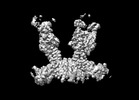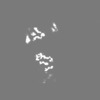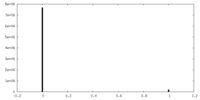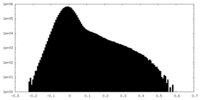+ Open data
Open data
- Basic information
Basic information
| Entry |  | |||||||||
|---|---|---|---|---|---|---|---|---|---|---|
| Title | HBcAg-D4 Fab complex | |||||||||
 Map data Map data | ||||||||||
 Sample Sample |
| |||||||||
 Keywords Keywords | ASU / D4 Antibody / HBcAg VLP / VIRUS LIKE PARTICLE / VIRAL PROTEIN-IMMUNE SYSTEM complex | |||||||||
| Function / homology |  Function and homology information Function and homology informationmicrotubule-dependent intracellular transport of viral material towards nucleus / T=4 icosahedral viral capsid / viral penetration into host nucleus / host cell / host cell cytoplasm / symbiont entry into host cell / structural molecule activity / DNA binding / RNA binding Similarity search - Function | |||||||||
| Biological species |  Homo sapiens (human) / Homo sapiens (human) /  hepatitis B virus genotype C hepatitis B virus genotype C | |||||||||
| Method | single particle reconstruction / cryo EM / Resolution: 3.6 Å | |||||||||
 Authors Authors | Zhang Z / Ju B / Liu C / Yan H | |||||||||
| Funding support |  China, 1 items China, 1 items
| |||||||||
 Citation Citation |  Journal: J Virol / Year: 2025 Journal: J Virol / Year: 2025Title: The characterization and structural basis of a human broadly binding antibody to HBV core protein. Authors: Hu Yan / Congcong Liu / Yuxiao Li / Shilong Tang / Huimin Guo / Bing Zhou / Qing Fan / Haiyan Wang / Xiangyang Ge / Xin Wang / Xuejiao Liao / Jin Li / Zheng Zhang / Bin Ju /  Abstract: Hepatitis B virus (HBV) core protein (HBc) plays a crucial role in the virus life cycle, making it an important detection marker for HBV infection and a potential target for treatment. However, ...Hepatitis B virus (HBV) core protein (HBc) plays a crucial role in the virus life cycle, making it an important detection marker for HBV infection and a potential target for treatment. However, several commercially available monoclonal antibodies (mAbs) or polyclonal antibodies (pAbs) targeting HBc have certain limitations in detecting HBV across different genotypes in various biochemical assays, such as enzyme-linked immunosorbent assay, western blot, immunofluorescence assay, flow cytometry, and immune spot assay. In this study, we identified 12 human anti-HBc mAbs and evaluated their potential application in multiple biochemical assays. These mAbs mainly recognized the epitopes near residues 20-22 amino acids (a.a.) and 77-78 a.a. of HBc, demonstrating a broadly cross-genotypic activity. Notably, three Group II mAbs, named cAbA1, cAbD4, and cAbF9, displayed excellent capacities for the detection of HBV infection in all tested biochemical assays. Furthermore, we determined a 3.22 Å of cryo-electron microscopy (cryo-EM) structure of the fragment of antigen binding (Fab) of cAbD4 complexed with HBc dimer, which was the highest resolution of the structural model for Fab-HBc to date. Collectively, our findings provided excellent and reliable antibody candidates for live HBV detection and revealed the recognition mechanism and the detailed interaction information of a potent human anti-HBc mAb binding to the spike tips of HBc dimer.IMPORTANCEThe lack of excellent detection Abs for live hepatitis B virus (HBV) infection and high-resolution structures of the Ab-HBV core protein (HBc) complex largely limited the development of HBV-related research. This study reports a panel of anti-HBc monoclonal antibodies (mAbs) with excellent capacities for detecting HBV infection in multiple biochemical assays and determines a 3.22 Å of cryo-EM structure of HBc with a potent binding mAb. These findings provide excellent and reliable detecting tools for HBV-related research and promote the understanding of the recognition mechanism of anti-HBc mAbs to HBc particles. | |||||||||
| History |
|
- Structure visualization
Structure visualization
| Supplemental images |
|---|
- Downloads & links
Downloads & links
-EMDB archive
| Map data |  emd_60396.map.gz emd_60396.map.gz | 27.3 MB |  EMDB map data format EMDB map data format | |
|---|---|---|---|---|
| Header (meta data) |  emd-60396-v30.xml emd-60396-v30.xml emd-60396.xml emd-60396.xml | 21.1 KB 21.1 KB | Display Display |  EMDB header EMDB header |
| FSC (resolution estimation) |  emd_60396_fsc.xml emd_60396_fsc.xml | 6.5 KB | Display |  FSC data file FSC data file |
| Images |  emd_60396.png emd_60396.png | 50.9 KB | ||
| Masks |  emd_60396_msk_1.map emd_60396_msk_1.map | 30.5 MB |  Mask map Mask map | |
| Filedesc metadata |  emd-60396.cif.gz emd-60396.cif.gz | 6.4 KB | ||
| Others |  emd_60396_half_map_1.map.gz emd_60396_half_map_1.map.gz emd_60396_half_map_2.map.gz emd_60396_half_map_2.map.gz | 28.4 MB 28.4 MB | ||
| Archive directory |  http://ftp.pdbj.org/pub/emdb/structures/EMD-60396 http://ftp.pdbj.org/pub/emdb/structures/EMD-60396 ftp://ftp.pdbj.org/pub/emdb/structures/EMD-60396 ftp://ftp.pdbj.org/pub/emdb/structures/EMD-60396 | HTTPS FTP |
-Validation report
| Summary document |  emd_60396_validation.pdf.gz emd_60396_validation.pdf.gz | 843.4 KB | Display |  EMDB validaton report EMDB validaton report |
|---|---|---|---|---|
| Full document |  emd_60396_full_validation.pdf.gz emd_60396_full_validation.pdf.gz | 843 KB | Display | |
| Data in XML |  emd_60396_validation.xml.gz emd_60396_validation.xml.gz | 13.8 KB | Display | |
| Data in CIF |  emd_60396_validation.cif.gz emd_60396_validation.cif.gz | 17.9 KB | Display | |
| Arichive directory |  https://ftp.pdbj.org/pub/emdb/validation_reports/EMD-60396 https://ftp.pdbj.org/pub/emdb/validation_reports/EMD-60396 ftp://ftp.pdbj.org/pub/emdb/validation_reports/EMD-60396 ftp://ftp.pdbj.org/pub/emdb/validation_reports/EMD-60396 | HTTPS FTP |
-Related structure data
| Related structure data |  8zrhMC  8zreC  8zrrC C: citing same article ( M: atomic model generated by this map |
|---|---|
| Similar structure data | Similarity search - Function & homology  F&H Search F&H Search |
- Links
Links
| EMDB pages |  EMDB (EBI/PDBe) / EMDB (EBI/PDBe) /  EMDataResource EMDataResource |
|---|---|
| Related items in Molecule of the Month |
- Map
Map
| File |  Download / File: emd_60396.map.gz / Format: CCP4 / Size: 30.5 MB / Type: IMAGE STORED AS FLOATING POINT NUMBER (4 BYTES) Download / File: emd_60396.map.gz / Format: CCP4 / Size: 30.5 MB / Type: IMAGE STORED AS FLOATING POINT NUMBER (4 BYTES) | ||||||||||||||||||||||||||||||||||||
|---|---|---|---|---|---|---|---|---|---|---|---|---|---|---|---|---|---|---|---|---|---|---|---|---|---|---|---|---|---|---|---|---|---|---|---|---|---|
| Projections & slices | Image control
Images are generated by Spider. | ||||||||||||||||||||||||||||||||||||
| Voxel size | X=Y=Z: 1.074 Å | ||||||||||||||||||||||||||||||||||||
| Density |
| ||||||||||||||||||||||||||||||||||||
| Symmetry | Space group: 1 | ||||||||||||||||||||||||||||||||||||
| Details | EMDB XML:
|
-Supplemental data
-Mask #1
| File |  emd_60396_msk_1.map emd_60396_msk_1.map | ||||||||||||
|---|---|---|---|---|---|---|---|---|---|---|---|---|---|
| Projections & Slices |
| ||||||||||||
| Density Histograms |
-Half map: #2
| File | emd_60396_half_map_1.map | ||||||||||||
|---|---|---|---|---|---|---|---|---|---|---|---|---|---|
| Projections & Slices |
| ||||||||||||
| Density Histograms |
-Half map: #1
| File | emd_60396_half_map_2.map | ||||||||||||
|---|---|---|---|---|---|---|---|---|---|---|---|---|---|
| Projections & Slices |
| ||||||||||||
| Density Histograms |
- Sample components
Sample components
-Entire : Asymmetric unit of the complex between HBV capsid and D4 Fab
| Entire | Name: Asymmetric unit of the complex between HBV capsid and D4 Fab |
|---|---|
| Components |
|
-Supramolecule #1: Asymmetric unit of the complex between HBV capsid and D4 Fab
| Supramolecule | Name: Asymmetric unit of the complex between HBV capsid and D4 Fab type: complex / ID: 1 / Parent: 0 / Macromolecule list: #2-#3, #1 |
|---|---|
| Source (natural) | Organism:  Homo sapiens (human) Homo sapiens (human) |
-Macromolecule #1: Capsid protein
| Macromolecule | Name: Capsid protein / type: protein_or_peptide / ID: 1 / Number of copies: 4 / Enantiomer: LEVO |
|---|---|
| Source (natural) | Organism:  hepatitis B virus genotype C hepatitis B virus genotype C |
| Molecular weight | Theoretical: 16.097427 KDa |
| Recombinant expression | Organism:  Escherichia phage EcSzw-2 (virus) Escherichia phage EcSzw-2 (virus) |
| Sequence | String: MDIDPYKEFG ASVELLSFLP SDFFPSIRDL LDTASALYRE ALESPEHCSP HHTALRQAIL CWGELMNLAT WVGSNLEDPA SRELVVSYV NVNMGLKIRQ LLWFHISCLT FGRETVLEYL VSFGVWIRTP PAYRPPNAPI LST UniProtKB: Capsid protein |
-Macromolecule #2: Heavy chains of D4 Fab
| Macromolecule | Name: Heavy chains of D4 Fab / type: protein_or_peptide / ID: 2 / Number of copies: 2 / Enantiomer: LEVO |
|---|---|
| Source (natural) | Organism:  Homo sapiens (human) Homo sapiens (human) |
| Molecular weight | Theoretical: 13.342837 KDa |
| Recombinant expression | Organism:  Homo sapiens (human) Homo sapiens (human) |
| Sequence | String: QVQLVESGGG VVQPGRSLRL SCAASGFNFN KFGMHWVRQV PGKGLEWLTY IWYDGSNADY VDSVKGRFTI SRDNSINTLY LQMNSLRAD DTAVYFCARG FYDSSSLESW GQGALVIVSS AS |
-Macromolecule #3: Light chains of D4 Fab
| Macromolecule | Name: Light chains of D4 Fab / type: protein_or_peptide / ID: 3 / Number of copies: 2 / Enantiomer: LEVO |
|---|---|
| Source (natural) | Organism:  Homo sapiens (human) Homo sapiens (human) |
| Molecular weight | Theoretical: 12.504955 KDa |
| Recombinant expression | Organism:  Homo sapiens (human) Homo sapiens (human) |
| Sequence | String: DIVMTQSPLS LAVTPGEPAS ISCRSSQTLL HNNGYNYFSW YLQKPGQAPQ LLIYLGSNRA PGVSDRFSGS GSGTSFTLEI SRVEAEDVG VYYCMQGRHT PWTFGQGTKV EIKRT |
-Experimental details
-Structure determination
| Method | cryo EM |
|---|---|
 Processing Processing | single particle reconstruction |
| Aggregation state | particle |
- Sample preparation
Sample preparation
| Concentration | 3 mg/mL |
|---|---|
| Buffer | pH: 7.4 |
| Grid | Model: Quantifoil R1.2/1.3 / Material: COPPER / Mesh: 300 / Support film - Material: CARBON / Support film - topology: HOLEY / Pretreatment - Type: GLOW DISCHARGE / Pretreatment - Time: 75 sec. / Pretreatment - Atmosphere: AIR |
| Vitrification | Cryogen name: ETHANE / Chamber humidity: 100 % / Chamber temperature: 277 K / Instrument: FEI VITROBOT MARK IV |
- Electron microscopy
Electron microscopy
| Microscope | FEI TITAN KRIOS |
|---|---|
| Temperature | Min: 70.0 K / Max: 70.0 K |
| Image recording | Film or detector model: FEI FALCON IV (4k x 4k) / Digitization - Dimensions - Width: 4096 pixel / Digitization - Dimensions - Height: 4096 pixel / Number grids imaged: 1 / Number real images: 4137 / Average exposure time: 4.0 sec. / Average electron dose: 60.0 e/Å2 |
| Electron beam | Acceleration voltage: 300 kV / Electron source:  FIELD EMISSION GUN FIELD EMISSION GUN |
| Electron optics | C2 aperture diameter: 70.0 µm / Calibrated defocus max: 3.0 µm / Calibrated defocus min: 1.2 µm / Illumination mode: FLOOD BEAM / Imaging mode: BRIGHT FIELD / Cs: 2.7 mm / Nominal defocus max: 2.5 µm / Nominal defocus min: 1.5 µm |
| Sample stage | Specimen holder model: FEI TITAN KRIOS AUTOGRID HOLDER / Cooling holder cryogen: NITROGEN |
| Experimental equipment |  Model: Titan Krios / Image courtesy: FEI Company |
+ Image processing
Image processing
-Atomic model buiding 1
| Initial model |
| ||||||||
|---|---|---|---|---|---|---|---|---|---|
| Refinement | Space: REAL / Protocol: RIGID BODY FIT / Target criteria: cross-correlation coefficient | ||||||||
| Output model |  PDB-8zrh: |
 Movie
Movie Controller
Controller








 Z (Sec.)
Z (Sec.) Y (Row.)
Y (Row.) X (Col.)
X (Col.)















































